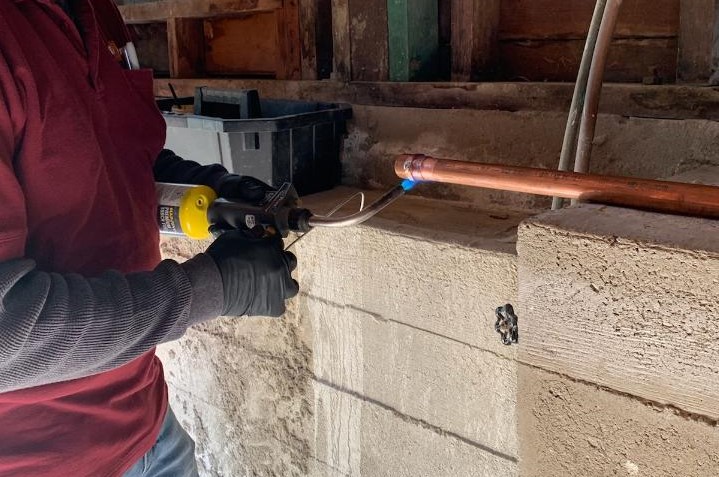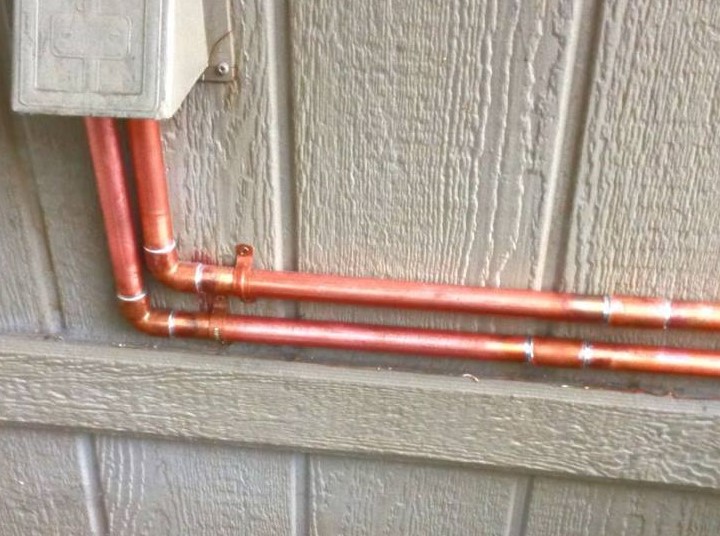
If you’ve noticed a dip in water quality or pressure in your home, you may be in need of a water line replacement. Photo: Duncan Plumbing Ent., Inc. ©2020
Have you noticed unusual developments in your home’s water pressure or quality? It’s possible that you need a water line replacement. But how can you know for sure if this is necessary? And if it is, what options do you have? What if you can’t afford to replace your water lines?
In the following article, we’ll answer these questions and more with the help of Diamond Certified Expert Contributor Bill Shepherd, owner of Shepherd’s Plumbing Heating & Air Conditioning, Inc. in Mountain View.
A tale of two water pipes
Before we get into the symptoms of water line failure, we need to talk about the lines themselves. Until very recently, almost all residential water piping was composed of either galvanized steel or copper. The type of piping you have in your home will in large part determine whether you need a water line replacement…but even then, it may not be that simple. To get some context, let’s look at some background information on these two types of pipe.
Galvanized steel piping
Since steel is vulnerable to corrosion, it must be “galvanized” before it can be used for water piping. To achieve this, the pipe must be coated with zinc via a chemical process of electrolysis, aka “electroplating.” This zinc layer protects the steel pipe from the effects of corrosion. As the zinc wears off over time, the pipe will begin to deteriorate.
Typically, galvanized water piping doesn’t have the same lifespan that copper does. However, as Mr. Shepherd explains, this can depend on the pipe’s age. “A lot of the galvanized piping that was made around the turn of the century up until the 1920s and ’30s is actually still in really great shape—even a century later, it looks brand new on the inside. That’s because during that period, the galvanization process was really good. Around the mid-’50s, the quality started to fall off with galvanized pipe manufacturing. When a lot of the U.S. steel companies shut down in the mid-’70s, we started getting most of our galvanized steel piping from overseas. The quality of this piping is horrible—because of an inferior galvanization process, the pipes just can’t handle the corrosive action and wear out very quickly. That’s why a lot of the water piping in homes built since then now needs to be replaced.”
Copper piping
Copper is a naturally corrosion-resistant metal that started being used for water piping in the late 1930s. Because of copper’s durability, most old copper water lines are still in really good shape multiple decades later. For this reason, the likelihood of having to do a repiping project on a home that already has copper piping is very low. Even if there are leaks, these are typically very easy to fix.
Signs you might need a water line replacement
Galvanized steel water lines are more likely to require replacement than copper, but it’s not always easy to tell if and when this is needed. Fortunately, there are a few telltale signs that can clue you in:
- Low water pressure across several water fixtures in your home. In some cases, this symptom may be isolated to a specific area of the home, such as the bathroom. In all cases, the symptoms will apply to more than one fixture. If you’re having an issue with an individual fixture, it may just be a plugged aerator.
- Frequent leaks. One leak is not indicative that you need to repipe, but if you have two, three or four leaks in quick succession on a galvanized water system, that’s a pretty clear sign.
- Orange color or chunks of orange debris in your water. These are signs that the galvanized steel pipe is literally disintegrating from the inside out.
If you notice one or more of these symptoms, you should call a plumber to come out and inspect your water lines.

Copper piping is one of several options for water line replacement. Photo: R.P.S. Ribbs Premier Services Plumbing – Rooter ©2020
Options for water line replacement
When it comes to replacing residential water lines, there are three basic options: copper, PEX or CPVC.
Copper
Copper is the gold standard for water piping. As a reliable alternative to plastic and galvanized pipes, it stands up against leaks, doesn’t add pollutants to water and has a long lifespan.
PEX
PEX is made of crosslinked polyethylene, which makes it both stronger and more flexible than average plastic piping. Unlike copper pipes, which are soldered together, PEX pipes are connected with compression fittings that are adhered using a clamping machine.
CPVC
CPVC piping is a rigid plastic product whose fittings are adhered with glue.
Disadvantages of plastic water piping (compared to copper)
- Rodents love to chew on plastic, so if you choose to install plastic water lines, be sure to keep rodents out. If you live in a rural area, plastic piping is not recommended for this reason.
- Because of their smaller inner diameter, you may run into sizing issues with PEX and CPVC water lines. Where you’d only need to run half-inch copper piping, you may have to run three-quarter or five-eighths PEX to get the same amount of water flow.
- Even a stronger plastic piping like PEX isn’t nearly as resistant to damage as copper. If you grab a copper pipe and pull on it, it’ll merely bend, whereas a plastic pipe will likely break.
Other things to know about water line replacement
- Even though there are three options for water piping, depending on what jurisdiction you live in, you may have as few as one. For example, San Francisco doesn’t allow any plastic piping—you have to install copper. Most other jurisdictions allow some form of plastic piping for water lines, but not always both.
- Copper piping comes in three grades: Type M (lowest quality), Type L (commercial grade) and Type K (highest quality). Since Type M is low-quality and Type K is prohibitively expensive, Type L is usually the best option for a home or commercial property. It’s not that much more expensive than Type M, but it has about double the lifespan.
- When buying copper piping, be sure to get it from a plumbing supplier, not a hardware store. Even if it’s technically the same grade, the quality of the piping at the hardware store won’t be as good.
What to do if you can’t afford to replace your water lines
Residential water line replacement isn’t cheap, and depending on the size of your home, the price tag can be astronomical. So, what if you need new water lines but don’t have the budget to replace them?
Good news: you have options. Mr. Shepherd gives a real-life example. “We have one client who needs new water pipes but can’t afford the cost. So, each year we perform an inspection on their home and make sure there aren’t any unidentified leaks. If we find a leak, we just do a spot repair on that section of pipe. It’s certainly not ideal, but we’ve been working with them for about four years now and we’ve been able to make their system limp by.”
Another option Mr. Shepherd suggests is doing a partial repipe. “There are certain areas of a galvanized system that tend to fail faster than others,” he explains. “For example, the first 20 to 30 feet of the hot water line that leaves the water heater gets a little more corrosive action because of the temperature swings and water flowing through. So, if you’re having a lot of problems, it might make sense to address the pipes within that area. Another option is to replace only the horizontal water lines beneath the home and leave the lines that are in the walls—since there’s no drywall to deal with, those lines are less expensive to replace. This can be an affordable way to start a long-term water line replacement project.”
Find a Diamond Certified plumbing company in your area
